Sie sind eine neue Website und konkurrieren mit einem Marketingriesen in Ihrer Branche? Sie geben wahrscheinlich mehr Geld für Google-Anzeigen aus als Sie (und andere Konkurrenten) und saugen den gesamten Datenverkehr in der organischen Suche auf. Sie denken wahrscheinlich, dass es sich nicht lohnt, SEO zu betreiben. Wie wollen Sie mit diesen Branchenriesen konkurrieren?
Aber lassen Sie sich von Ihren größten Konkurrenten nicht davon abschrecken, in SEO zu investieren.
Die Wahrheit ist, dass Ihr Publikum Sie nicht finden kann, wenn Sie kein SEO betreiben, und dass Sie auch nicht in der Lage sein werden, mit den großen Playern zu konkurrieren. Beim Vergleich SEO vs. Google-Anzeigenist es wichtig, die langfristigen Vorteile von SEO zu erkennen. Während Google Ads für sofortige Sichtbarkeit sorgen können, hilft Ihnen SEO, organischen Traffic aufzubauen, der dauerhaft anhält.
Lesen Sie weiter, um herauszufinden, warum es gut ist, große Konkurrenten zu haben, und warum SEO Ihnen helfen kann, vor ihnen zu rangieren. Wir zeigen Ihnen sogar drei SEO-Taktiken, mit denen Sie Ihre Seiten von der Konkurrenz abheben können, darunter:
- Taktik #1 - Ethischer Diebstahl von Marken-Traffic der Konkurrenz
- Taktik #2 - Konkurrierende Schlüsselwörter auf ethische Weise stehlen
- Taktik #3 - Finden von Unterkategorien, die Ihre Konkurrenz verpasst hat
Jede Methode ist wichtig, um aktuelle Autorität aufzubauen und Branchenriesen zu schlagen, selbst wenn Ihr Domain-Rating (DR) meilenweit hinter ihnen liegt.
Erkennen von SEO-Möglichkeiten
Wenn Sie Ihren Online-Bereich analysieren, werden Sie wahrscheinlich feststellen, dass Branchenriesen das Feld beherrschen. Sie zeigen in der Regel drei Dinge:
- Sie haben beachtliche Domainbewertungen von 80+
- Sie erhalten eine beträchtliche Menge an Datenverkehr von den Ergebnisseiten der Suchmaschinen (SERPs)
- Sie haben ein hohes Markenbewusstsein
Was denken Sie, wenn Sie sehen, dass eine Marke dies erreicht?
Viele machen sich Sorgen, dass ihr Unternehmen nicht mithalten kann. Vielleicht glauben Sie, dass Sie in diesem Bereich nicht konkurrieren können, weil diese bekannten Marken den ganzen Verkehr an sich reißen.
Es ist nicht ungewöhnlich, dass Unternehmen diese großen Player sehen und Angst bekommen, dass sie nicht wachsen können. Aber was wäre, wenn wir Ihnen sagen würden, dass dies KEIN Indikator ist, um SEO-Bemühungen einzustellen? Es ist auch kein Grund, SEO nicht weiter zu verfolgen. Im Gegenteil, es ist genau das Richtige.
Wenn die Branchenriesen die Nische beherrschen, sagt uns das etwas sehr Wichtiges:
Hier liegt eine Chance.
Neudefinition des Verkehrsaufkommens der Wettbewerber als positiver Wachstumsindikator
Thematische Schlüsselwörter bringen Traffic, und die großen Unternehmen erhalten Leads und Verkäufe. Diese Indikatoren bedeuten, dass Ihr Unternehmen die Möglichkeit hat, den vorhandenen Traffic anzuziehen und in zahlende Kunden zu verwandeln.
Das ist eine weitaus bessere Position, als wenn Ihre Konkurrenten keinen Traffic bekommen, denn das zeigt, dass es in Ihrer Nische nicht genug Nachfrage gibt. Sie können dies feststellen, wenn Sie ein neues Konzept oder Produkt erfinden.
Angenommen, Sie entwickeln ein Produkt oder eine Dienstleistung, die ein bestimmtes Problem löst. Wenn es in der Nische nicht genügend Nachfrage gibt, bedeutet dies im Wesentlichen, dass die Zahl der Menschen, die eine Lösung für dieses Problem suchen, minimal ist. Wenn der Lösungsverkehr gering ist, sind Sie gezwungen, an die Spitze des Trichters zu gehen, um Kunden zu finden.
Wenn Sie sich also in einer Situation befinden, in der große Marken den gesamten Verkehr auf sich ziehen, bedeutet das nicht, dass Sie selbst keinen Zugang zu diesem Verkehr haben. Vielmehr ist es ein gutes Zeichen für ein ausreichendes Interesse an Ihrer Branche. Sogar Nischenbranchen wie Vape-Shops können von gezielten SEO-Maßnahmen stark profitieren. Durch die Verwendung von vape SEO Strategienkönnen Unternehmen einen höheren Rang einnehmen und diese bestehende Nachfrage nutzen.
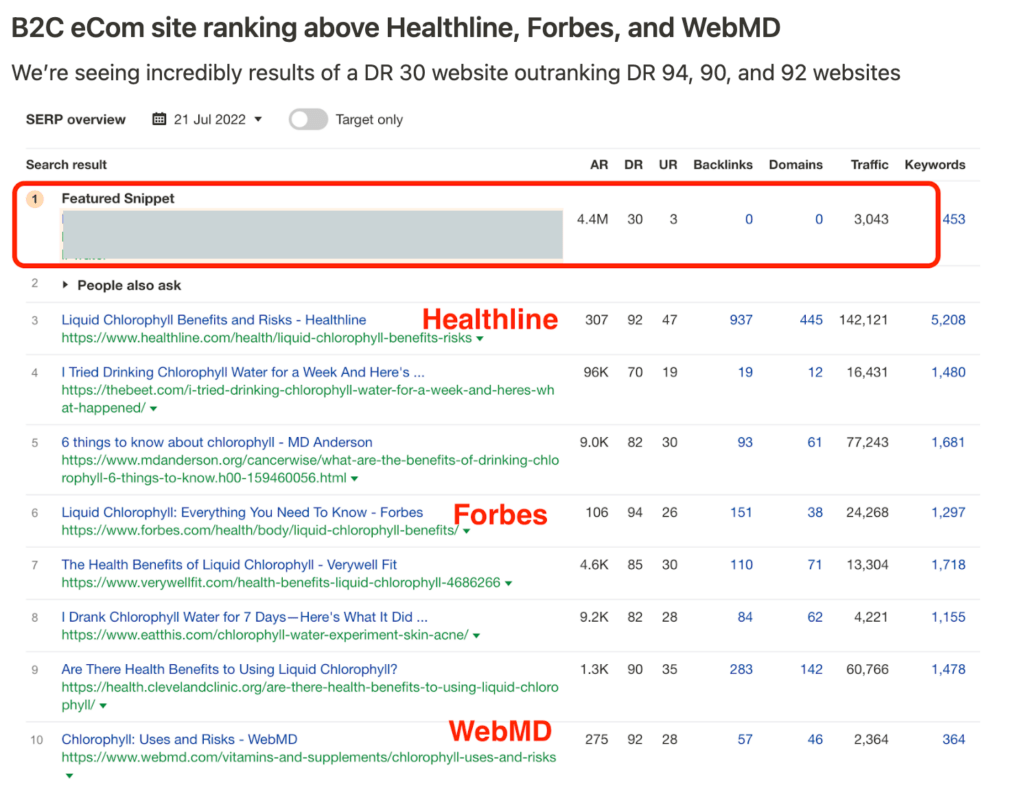
Der obige Screenshot ist ein zentrales Beispiel dafür, dass unser Kunde im Ranking vor seinen Mitbewerbern liegt. Wie Sie sehen können, hat unser Kunde ein Domain-Rating von 30 und keine direkten Backlinks zu dieser speziellen Seite. Dieser Kunde gewann den Spitzenplatz vor Healthline, Forbes und WebMD, die hohe DRs und zahlreiche direkte Backlinks zu dieser Seite haben.
Natürlich ist es möglich, in Bereichen mit hoher Nachfrage nach Schlüsselwörtern Traffic zu erhalten, auch wenn man es mit einigen großen Playern im Spiel zu tun hat.
Sie können dies als einen positiven Indikator dafür ansehen, dass Ihre Nische eine SEO-Strategie unterstützen kann, denn ein großer Mitbewerber-Traffic zeigt, dass es einen Pool von vielen potenziellen Kunden gibt.
Im weiteren Verlauf dieses Artikels werden wir uns damit befassen, wie Sie Ihr Denken auf eine Haltung der Fülle umstellen können. Sie werden sehen, dass konkurrierender Verkehr eine Gelegenheit zum Wachstum ist und kein Indikator für Flucht.
Die 3 cleveren SEO-Taktiken, um die Giganten auszustechen
Autorität in Ihrem digitalen Bereich ist von grundlegender Bedeutung für ein gutes Ranking gegenüber Ihren Konkurrenten. Wenn Sie Fachwissen über das gesamte Thema vorweisen können, wird Google Ihre Website als eine maßgebliche Quelle wahrnehmen. Dieses umfassende Wissen wird als thematische Autorität bezeichnet.
Selbst wenn Ihre Konkurrenten den Großteil des Suchverkehrs auf sich ziehen, müssen Sie daran denken, dass noch mehr übrig bleibt. Wenn zum Beispiel eine Marke ¼ des Verkehrsvolumens auf sich zieht, bleiben immer noch ¾ übrig. Ganz zu schweigen von Hunderten weiterer Schlüsselwörter, auf die man abzielen kann. Um mehr Besucher in einer beliebten Nische anzuziehen, geht es nicht darum, den ersten Platz für das schwierigste Schlüsselwort zu gewinnen. Stattdessen geht es darum, viele Keywords mit einer hohen Intention anzuvisieren, um Google zu zeigen, dass Sie über thematische Autorität verfügen und bei zahlreichen Suchanfragen weit oben stehen.
Im folgenden Abschnitt werden drei clevere Taktiken vorgestellt, mit denen Sie Branchenriesen durch SEO überflügeln und Ihre thematische Autorität erhöhen können.
Taktik #1 Ethisches Stehlen von Marken-Traffic der Konkurrenz
Einer der Gründe dafür, dass Ihre Konkurrenten in ihrer Nische so viel Erfolg haben, könnte in der hervorragenden Markenbekanntheit liegen. Anstatt dies gegen Sie arbeiten zu lassen, besteht die erste Taktik darin, sich so aufzustellen, dass Sie bei Suchanfragen nach Marken der Konkurrenz erscheinen.
Warum sollten wir das tun?
Der Grund dafür ist einfach. Wenn die Menschen die Marke Ihres Konkurrenten als Branchenführer kennen, müssen Sie in diesen Suchanfragen auftauchen und potenziellen Kunden eine Alternative zu einem bekannten Namen bieten.
Erfahren Sie, wie Ihre Kunden suchen
Bevor Sie mit dem Schreiben oder Veröffentlichen von Seiten beginnen, ist es wichtig zu erfahren, wie Ihre Kunden suchen. Sie können einen neuen potenziellen Kunden bitten, Ihre Branche zu recherchieren und zu verstehen, indem Sie ihm die Aufgabe stellen, eine Lösung für ein allgemeines Problem zu finden. So können Sie herausfinden, wie sie Google nutzen, um eine Lösung für ihre Probleme zu finden. Dies ist ein sehr interessanter Ansatzpunkt, denn Sie sehen die Suchergebnisse und die Arten von Unternehmen, die über Ihrer Website oder Ihrer Lösung stehen.
Während Sie vielleicht eine Vorstellung davon haben, wer Ihre Konkurrenten aus der Perspektive des Geschäftsmodells sind, ist es entscheidend, diese Recherche aus der Sicht der Suchmaschinenoptimierung zu wiederholen, da die Konkurrenzlandschaft sehr unterschiedlich ist.
Während Sie Ihre Recherchen fortsetzen, müssen Sie die Konkurrenten und die Merkmale, die immer wieder in den SERPs auftauchen, im Auge behalten. Die am häufigsten auftauchenden Funktionen werden die Branche für jemanden definieren, der sich noch nie in diesem Bereich bewegt hat. Ein neuer Kunde wird schnell herausfinden, welche Lösungen zuerst und häufig auftauchen - für diese entscheiden sie sich dann in der Regel.
Analyse der Wettbewerber
Bevor Sie weitermachen, sollten Sie unbedingt den vorherigen Schritt abschließen. Nehmen Sie sich die Zeit, um zu verstehen, wie Ihre Kunden suchen, und um herauszufinden, welche Lösungen und Funktionen aus SEO-Sicht in der Branche führend sind.
Nun können Sie alle von Ihnen ermittelten Marken-Keywords und Merkmale in ein SEO-Software-Tool wie Ahrefs oder Semrush eingeben. Als Nächstes filtern Sie nach einer niedrigen Keyword-Schwierigkeit.
Anstatt sich auf die Konkurrenten zu konzentrieren, die Sie für bemerkenswert halten, müssen Sie sich bei der Suche nach Konkurrenten auf die Ergebnisse stützen, die Sie bei den Kundensuchen gefunden haben. Dabei müssen Sie alles ignorieren, was Sie derzeit über die Branche wissen.
Ethischer Diebstahl von Marken-Traffic der Konkurrenz: Fallstudie
Schauen wir uns ein Beispiel dafür an, wie sich diese SEO-Forschung der Mitbewerber zu einer effektiven Strategie entwickeln kann, um ihren Marken-Traffic zu stehlen.
In diesem Beispiel geht es um Legislate, ein Unternehmen für Vertragsvorlagen. Im Folgenden finden Sie zwei Beispiele dafür, wie sie diesen Ansatz effektiv genutzt haben.
Beispiel #1:
Als Legislate recherchierte, fanden sie heraus, dass DocuSign einer der führenden Akteure in ihrer Branche ist. Da diese Marke einen großen Teil des Verkehrsaufkommens auf sich zog, begannen sie, nach interessanten DocuSign-Keywords zu suchen.

Wie Sie auf dem Screengrab sehen können, war der DocuSign-Keyword-Cluster relativ leicht zu konkurrieren. Der Grund dafür ist wahrscheinlich, dass die Suchanfragen nicht sehr kommerziell ausgerichtet sind, sondern eher die Markenbekanntheit fördern.
Zum Glück für Legislate rangiert das Unternehmen relativ weit oben auf dieser Seite und positioniert sich als Alternative zu DocuSign. Ihre Meta-Tags wecken Zweifel an ihrem Konkurrenten und legen nahe, dass jemand andere Optionen in Betracht ziehen sollte. Jemand, der nach einer Marke wie dieser sucht, befindet sich in der Regel am Anfang des Verkaufstrichters. Alles, was Sie also tun müssen, ist, in diese Suchanfragen hineinzugehen, eine alternative Lösung zu präsentieren und zu suggerieren, dass DocuSign nicht die beste Option ist.
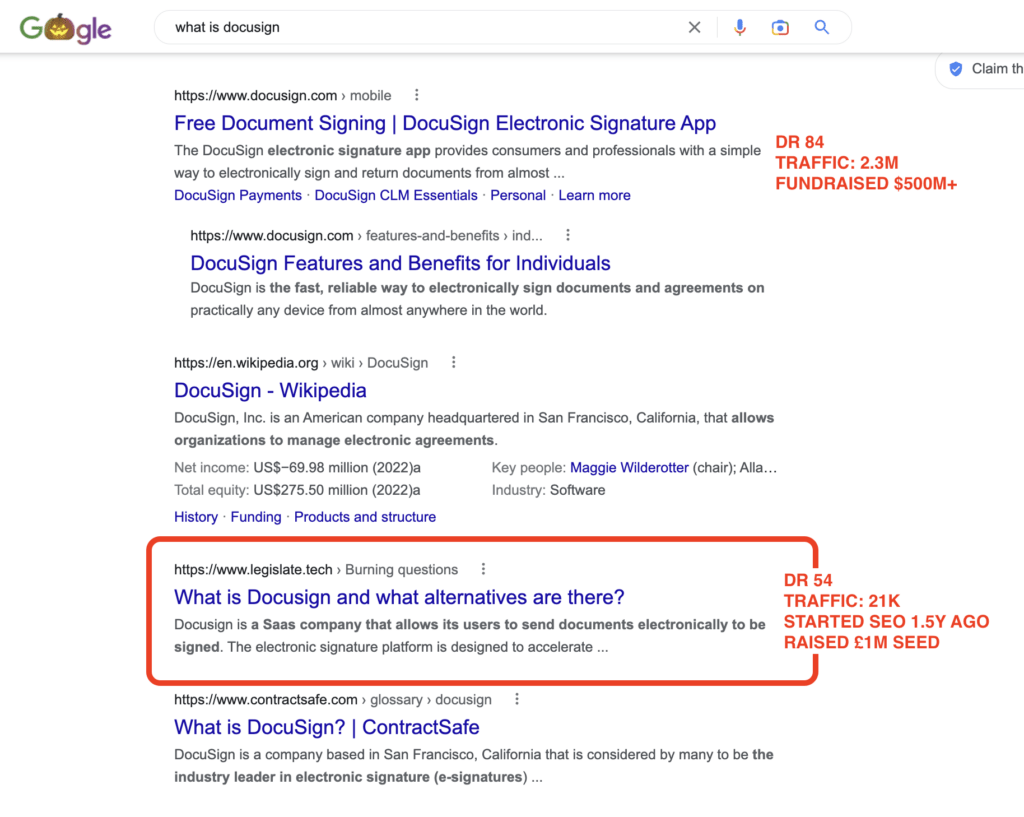
Beispiel #2:
Legislate entdeckte eine weitere Gelegenheit mit einem High Intent-Cluster rund um den Begriff "Whsmith tenancy agreement", der sich auf das große britische Einzelhandelsgeschäft bezieht. Interessanterweise handelt es sich dabei um einen kommerziellen Suchbegriff mit hoher Intention, was bedeutet, dass ein hoher Prozentsatz der Suchenden beabsichtigt, zu kaufen und in zahlende Kunden umzuwandeln - dies wird als Bottom-Funnel-Suche bezeichnet.
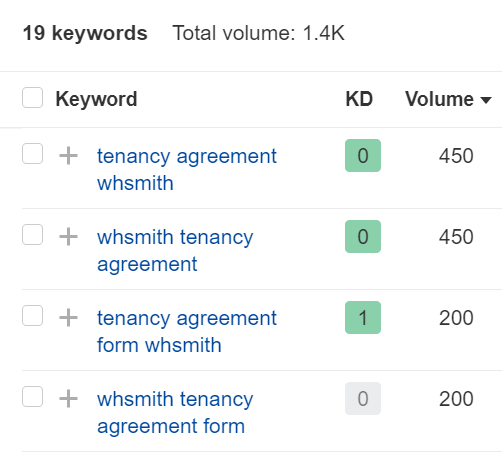
Da WHSmith eine so große Präsenz hat, verwendet Legislate diese markenbezogenen Suchbegriffe, die sich auf ihr Produkt, ihre Dienstleistung oder ihre Lösung beziehen, und vergleicht sich mit diesem Wettbewerber. Der untenstehende Screenshot zeigt den Erfolg bei diesen Suchbegriffen mit geringem Volumen, aber hoher Relevanz.
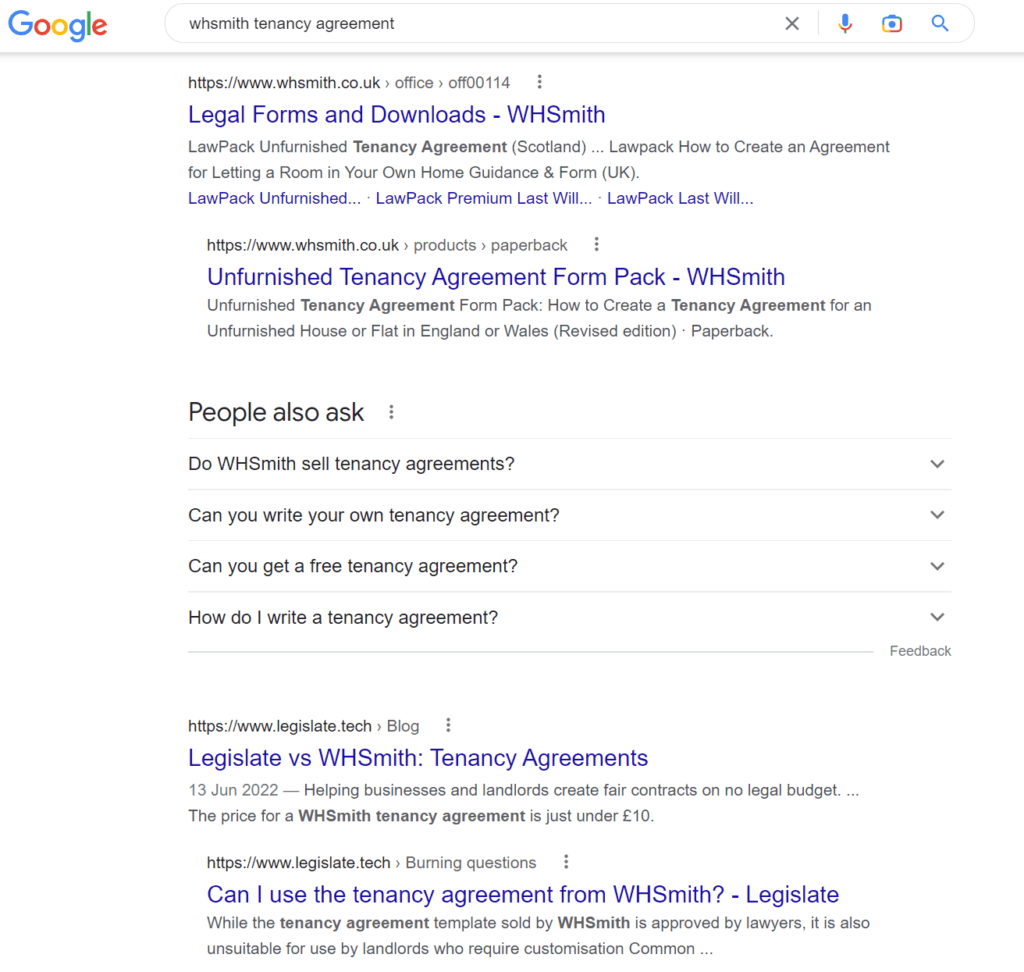
Die beiden oben genannten Beispiele sind hervorragende Beispiele dafür, wie man auf ethische Weise unter der Marke eines Wettbewerbers Datenverkehr stehlen kann. Legislate hat gezeigt, dass sie darauf geachtet haben, wie der Kunde sucht, indem sie Wettbewerber und Funktionen identifiziert haben. Während einige dieser Taktiken die Markenbekanntheit erhöhen, können andere in Bottom-Funnel-Suchen und zahlende Kunden umgewandelt werden.
Taktik #1 Spickzettel
Sie können Schlüsselwortcluster verwenden, um Artikel oder Landing Pages zu erstellen, die auf den Traffic der Konkurrenzmarke abzielen. Im Folgenden finden Sie einige gute Beispiele für Keyword-Formeln, die Sie ausprobieren können. Zum Beispiel könnten Sie, wie Legislate, eine Blogseite mit dem Titel "Legislate vs. DocuSign: Was ist besser?" verfassen oder eine Landing Page über DocuSign-Rezensionen schreiben und ihre eigene Lösung empfehlen. Es mag sich zwar kontraintuitiv anfühlen, einen Konkurrenten speziell zu besprechen, aber die Kunden wissen es zu schätzen, dass Sie ihnen helfen, eine Entscheidung zu treffen.
Schlüsselwortformeln zum Ausprobieren:
- {{Wettbewerber A}} gegen {{Wettbewerber B}}
- {{Konkurrent}} vs {{Feature}}
- Bestes {{Feature}} Werkzeug
- Was ist der {{Konkurrent}}
- {{Wettbewerber}} Preisgestaltung
- {{Wettbewerber}} Rabatt
- {{Wettbewerber}} Bewertungen
- Was ist falsch an {{Wettbewerber}}
Taktik #2 Ethisches Stehlen von Keywords der Konkurrenz
Im Wesentlichen bedeutet das Stehlen von Schlüsselwörtern Ihrer Konkurrenten, dass Sie die Seiten Ihrer Konkurrenten durchgehen und herausfinden, für welche Schlüsselwörter sie ranken und welche davon Sie nicht anvisieren.
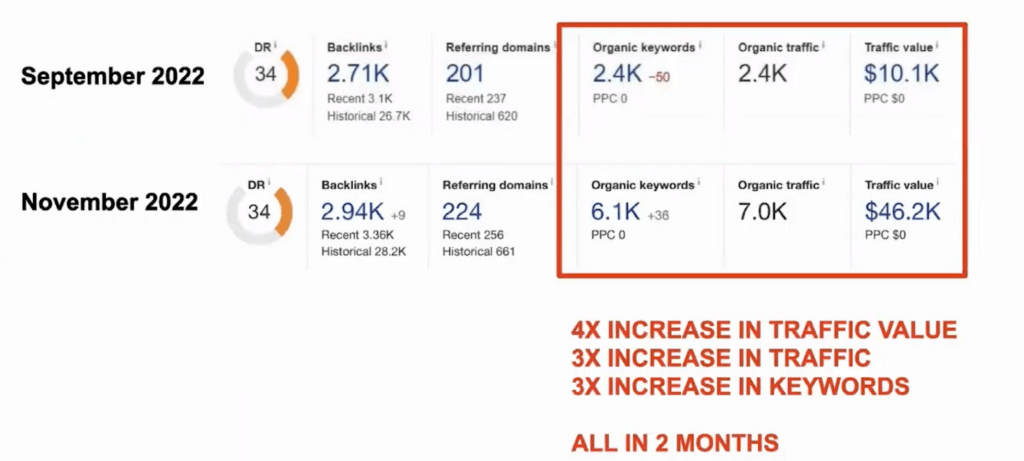
In diesem Fall stieg der Verkehrswert von September 2022 bis November 2022 von $10k pro Monat auf $46k pro Monat. Diese Zahlen bedeuten, dass der organische Traffic dieser Marke das Äquivalent von $46.200 pro Monat für Werbung wert ist. Außerdem stieg der organische Traffic von 2.400 auf 7.000 und die organischen Keywords von 2.400 auf 6.100.
Wie lässt sich dieser Ansatz nun auf Ihre Branche übertragen?
Zunächst sollten Sie die erste Taktik befolgt und die großen Akteure in Ihrer Branche ermittelt haben. Dieser Schritt zielt dann darauf ab, die Keywords zu untersuchen, für die Ihre Konkurrenten ranken. Auf diese Weise können Sie inhaltliche Lücken in Ihrer eigenen Strategie aufdecken und die Anzahl der Keywords erhöhen, auf die Sie abzielen. Im Folgenden erfahren Sie, wie Sie auf ethische Weise Keywords von Konkurrenten stehlen können:
- Gehen Sie zu ahrefs.com und fügen Sie Ihre Website-Domain zur Analyse hinzu
- Öffnen Sie 2 Registerkarten → Konkurrierende Domänen und Inhaltslücke
- Wählen Sie einige erfolgreiche Konkurrenten aus konkurrierenden Domains
- Fügen Sie sie dem Bericht "Inhaltslücke" hinzu
- Hier sehen Sie eine Liste von Keywords, für die Ihre Website nicht rangiert, Ihre Konkurrenten aber schon.
- Herausfiltern irrelevante Schlüsselwörter
- Laden Sie die Liste der Schlüsselwörter herunter
- Gruppieren Sie sie in relevante Schlüsselwort-Cluster nach Suchabsicht
Anhand des Erfolgs Ihrer Konkurrenten können Sie herausfinden, wo Sie Chancen verpassen, zu wachsen und bei Google zu ranken. Anhand der Liste der Keywords, für die Sie nicht ranken, können Sie diese Cluster nutzen, um qualitativ hochwertige Inhalte zu schreiben, die den Traffic und die thematische Autorität erhöhen.
Die Erstellung dieser Keyword-Cluster ist entscheidend für die Erstellung informativer Seiten, die Ihr tiefes Wissen zu einem bestimmten Thema zeigen. Auf diese Weise konnte unser Kunde im vorherigen Beispiel seine organischen Keywords, seinen Traffic und seinen Traffic-Wert in nur 2 Monaten um das 3-4-fache steigern.
Diese Taktik kann Ihnen auch dabei helfen, die Struktur der Websites Ihrer Konkurrenten zu erkennen und herauszufinden, wie sie an SEO herangehen. Einige nutzen zum Beispiel markenbezogene Schlüsselwörter, indem sie jeden einzelnen Markennamen ihrer Konkurrenten für die Erstellung von Landing Pages verwenden. Eine E-Commerce-Website hingegen könnte Landing Page-Kategorien für jeden Begriff erstellen.
Taktik #3 Unterkategorien finden, die Ihre Konkurrenz verpasst hat
Ihre Konkurrenten mögen für einige sehr schwierige Suchbegriffe weit oben rangieren, aber es gibt eine Fülle von Begriffen, mit denen sie sich nicht befassen. Es ist unmöglich, jedes einzelne Keyword in einer Kategorie ins Visier zu nehmen, daher gibt es natürlich zahlreiche Nischensuchbegriffe und -seiten, die diese großen Player nicht haben.
Bevor wir uns damit befassen, wie Sie diese identifizieren können, wollen wir erst einmal aufschlüsseln, warum Ihre Konkurrenz so viele Suchbegriffe unangetastet lässt. Dies sind einige der Gründe, warum viele Suchbegriffe unberücksichtigt bleiben:
- Geringes Suchvolumen
- Oberflächlich betrachtet sind sie nicht so beeindruckend, so dass die Entscheidungsträger den Nutzen oft nicht erkennen
- Weniger offensichtlich
- Blockiert durch Bürokratie
- Verlangsamung durch technische Teams
Es ist üblich, dass Entscheidungsträger wie CEOs, Manager usw. die bekanntesten Keywords in den Top 100 der Nischenbegriffe suchen. Es ist jedoch effizienter, statt auf breitere Keywords wie "Kreditkarten" auf Long-Tail-Begriffe wie "Kreditkarten für Freiberufler" zu zielen. Es ist nicht nur einfacher, auf diese Begriffe zu zielen und sie in den SERPs weiter oben zu platzieren, sondern es handelt sich auch um ein spezifisches Keyword mit hoher Bedeutung.
Die Konzentration auf Long-Tail-Keywords mit geringerem Volumen, aber hoher Intention ist für Ihr Unternehmen wohl vorteilhafter als die Ausrichtung auf ein übergreifendes Thema.
Identifizierung von Unterkategorien, die Ihre Konkurrenz verpasst hat: Fallstudie
Hier sind einige Beispiele für das Auffinden von Unterkategorien, die Ihre Konkurrenz übersehen hat. Angenommen, ein Hotel versucht, die inhaltlichen Lücken seiner Konkurrenten zu finden. Es hat es mit einer großen Konkurrenz wie Booking.com oder Kayak.com zu tun. Während diese jedoch Begriffe wie "beste Hotels in London" dominieren, können Sie mit spezifischeren Begriffen arbeiten, auf die sie sich nicht konzentrieren. Tatsächlich haben diese oft eine bessere Absicht und führen eher zu einem Kauf.
Anstelle des obigen Beispiels könnte ein Hotel auf spezifischere Suchanfragen abzielen, wie zum Beispiel:
- Bestes hundefreundliches Hotel in {{Stadt}}
- Bestes Hotel in {{Stadt}} für {{Zweck}}
- Hotels in {{Bezirk in der Stadt}}
- Hotel in der Nähe des {{Beliebten Wahrzeichens}}
Darüber hinaus können Sie im eCommerce Landing Pages und Produktkategorieseiten erstellen. Ein Geschäft für Hochzeitskleider kann beispielsweise Kategorien auf der Grundlage von Schlüsselwörtern wie "Vintage-Hochzeitskleider", "Prinzessinnen-Hochzeitskleid" und so weiter erstellen.
Es gibt zahlreiche Möglichkeiten, auf diese Keywords mit geringem Volumen abzuzielen. Achten Sie also auf die Strukturen, die Ihre Konkurrenten verwenden. Hier ist ein Beispiel dafür, wie Sie eine Unterkategorie für B2B-Dienstleistungen finden können:
- Sie haben Ihren {{Dienstname}}
- Zur Schlüsselwortanalyse auf ahrefs.com
- Schreiben Sie {{Dienstname}} + "für"
- Identifizieren Sie alle Schlüsselwörter, die dem Muster {{Dienstname}} folgen + für + {{Kundentyp}}
- Beispiel: PPC-Dienste für den eCommerce
- Beispiel: Rechtsberatung für kleine Unternehmen
- Erstellen von Clustern durch Gruppierung von Schlüsselwörtern nach Suchabsicht
- Entwickeln Sie Landing Pages für jede Gruppe

Letzte Erkenntnis
Wenn Sie zu Beginn der Lektüre dieses Artikels geglaubt haben, dass es unmöglich ist, eine DR 80+ Website zu übertreffen, wissen Sie jetzt hoffentlich, dass es möglich ist. Die drei oben genannten Taktiken bauen thematische Autorität auf und verbessern Ihre Chancen, Inhalte zu erstellen, die auf den vorderen Plätzen der SERPs ranken.
Indem Sie auf ethische Weise den Markenverkehr Ihrer Konkurrenten unterschlagen und in den Suchergebnissen als echte Alternative erscheinen, machen Sie den ersten Schritt zur Verbesserung des Markenbewusstseins und nehmen großen Konkurrenten einen Teil des Verkehrsflusses weg.
Um den Branchenriesen den Rang abzulaufen, müssen Sie darüber hinaus inhaltliche Lücken in Ihrer SEO-Strategie und der Ihrer Konkurrenten erkennen und beseitigen.
Es ist jedoch wichtig, dass Sie zunächst wissen, wie Ihre potenziellen Kunden Google nutzen, damit Sie wissen, welche Wettbewerber und Funktionen Sie beachten müssen. Schließlich sollten Sie alle drei Taktiken in dieser Reihenfolge anwenden, um sicherzustellen, dass Sie thematische Autorität aufbauen und keine wichtigen Wachstumschancen verpassen.